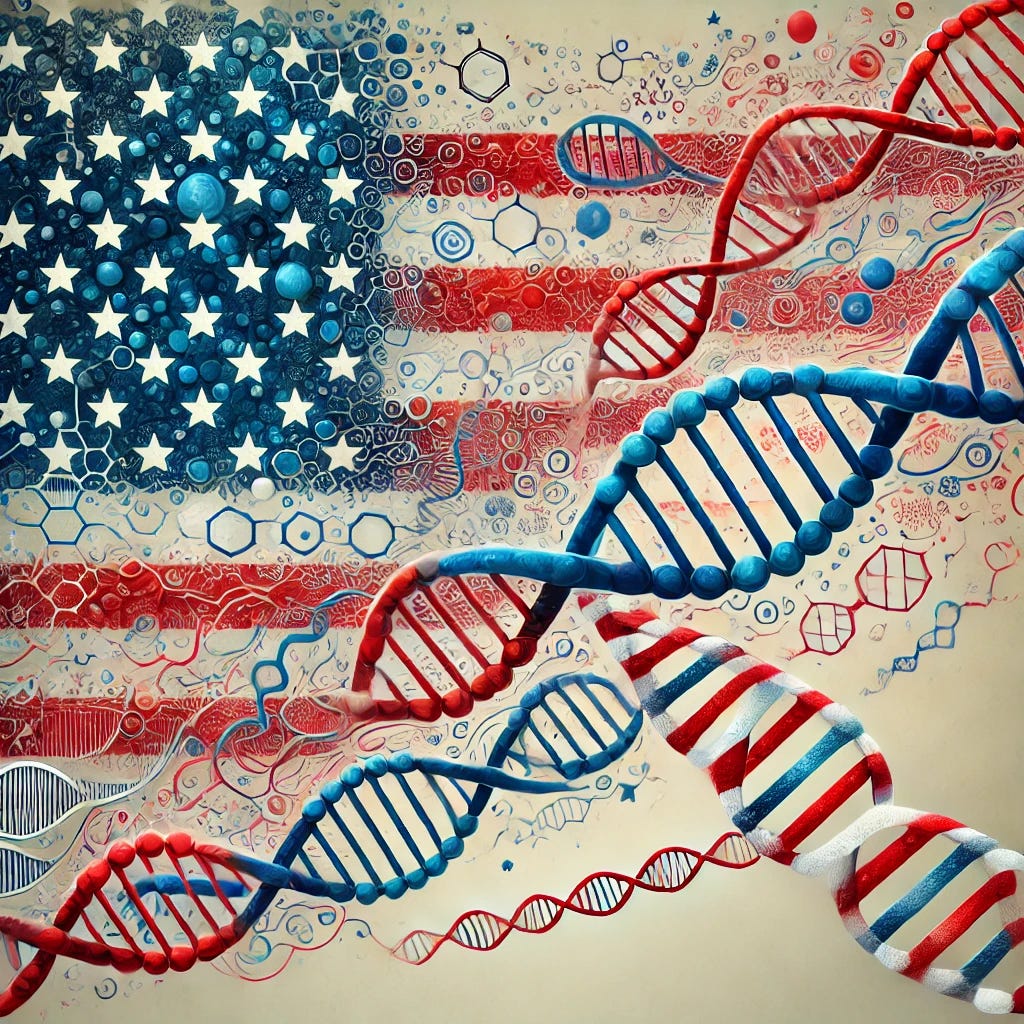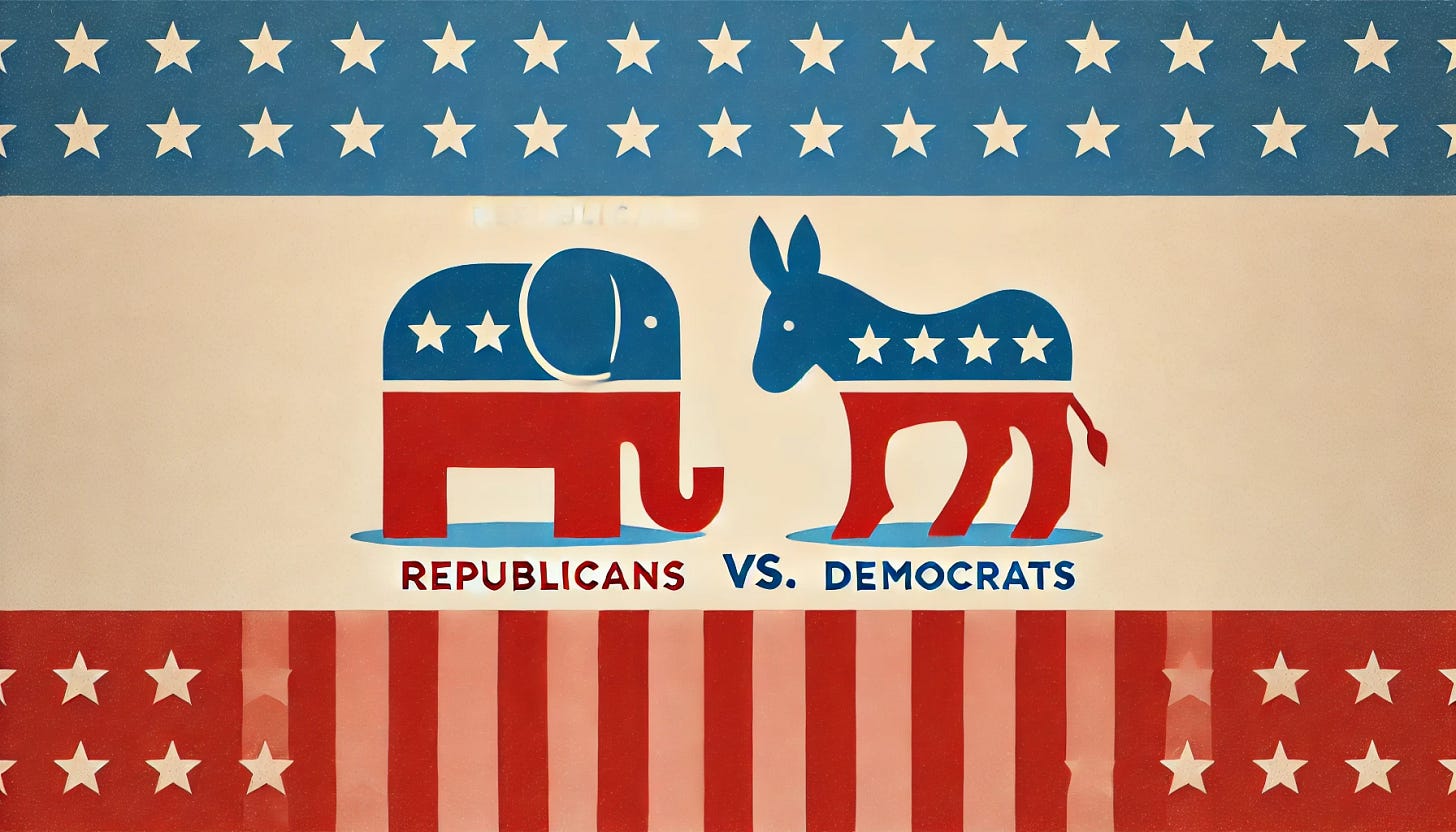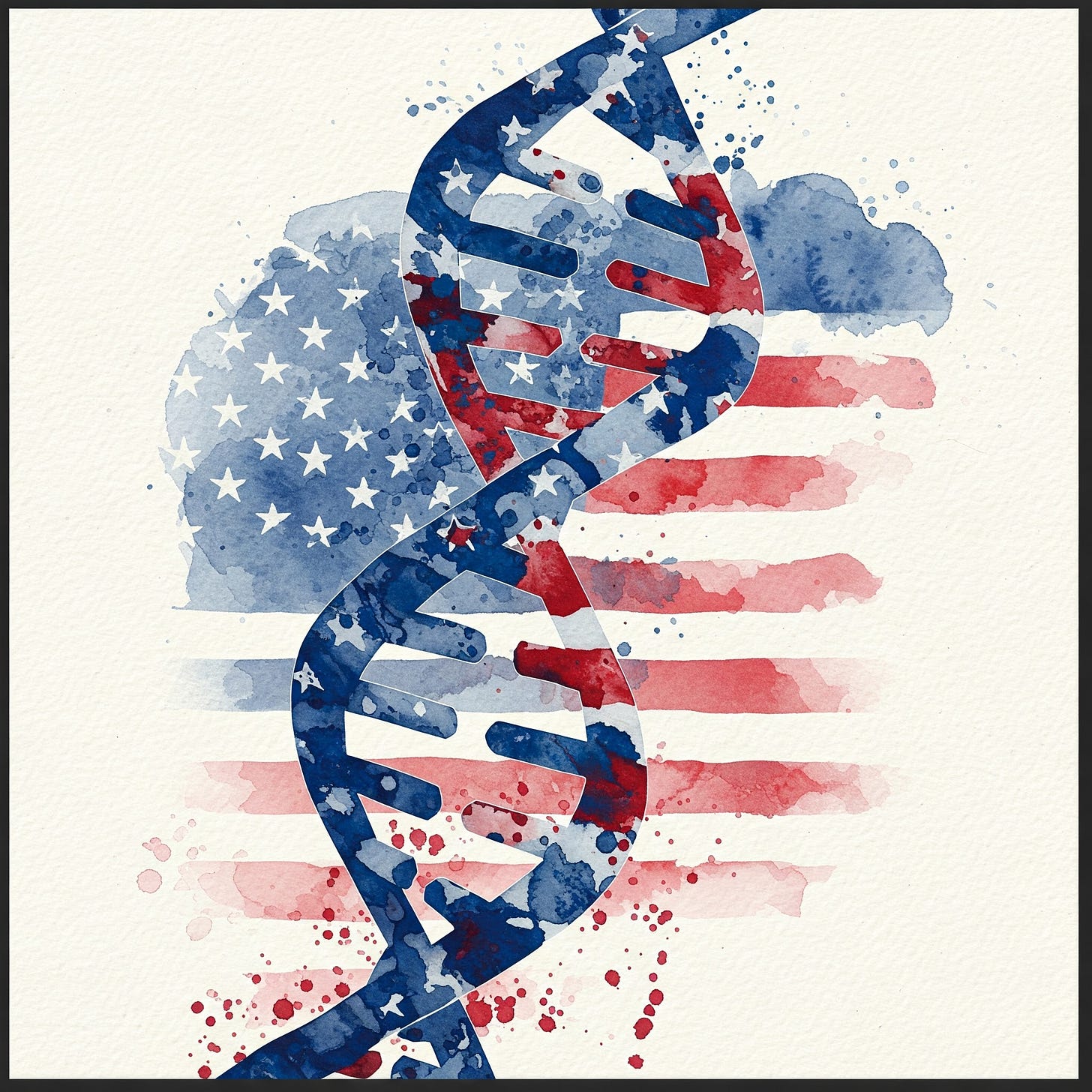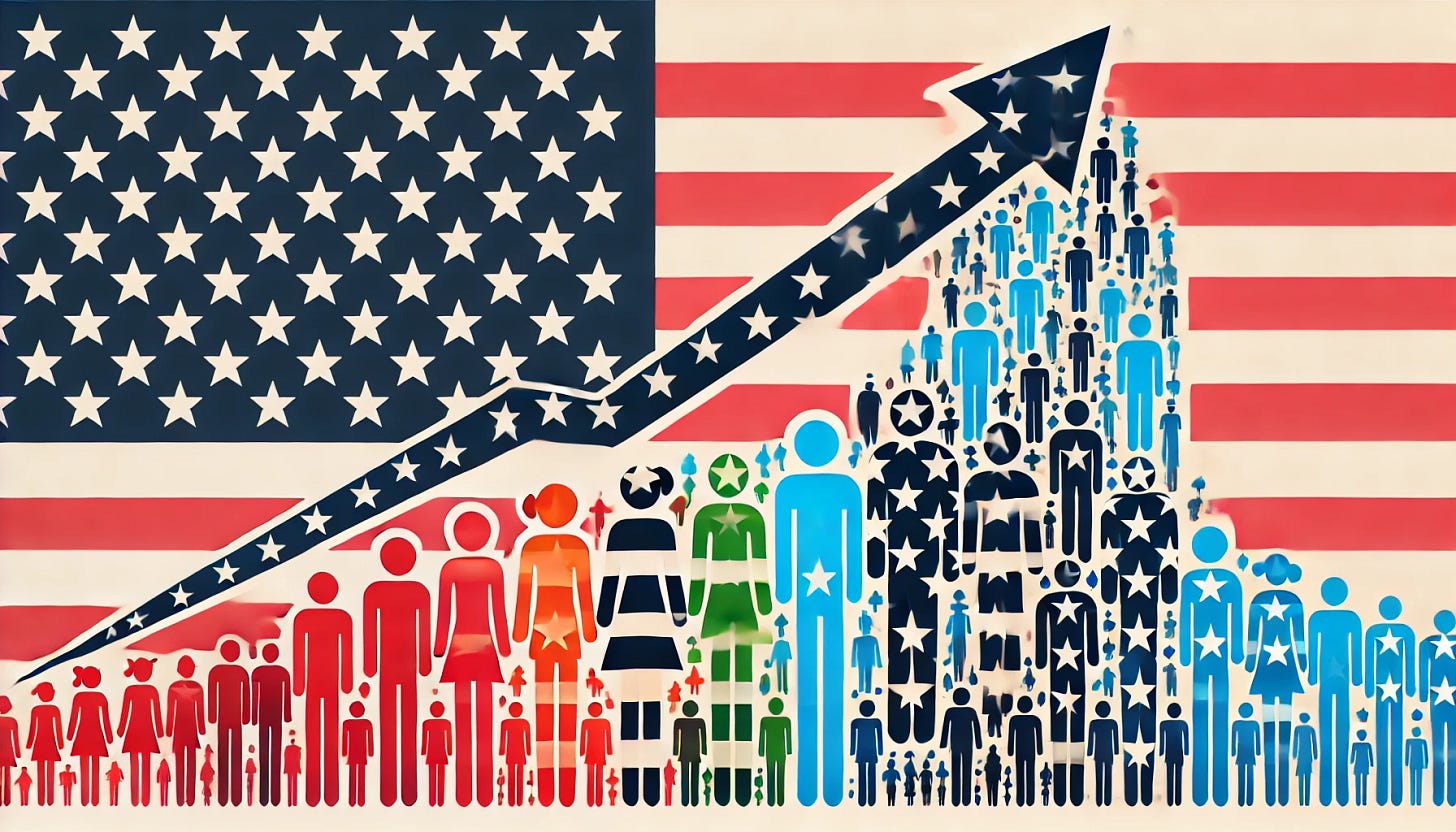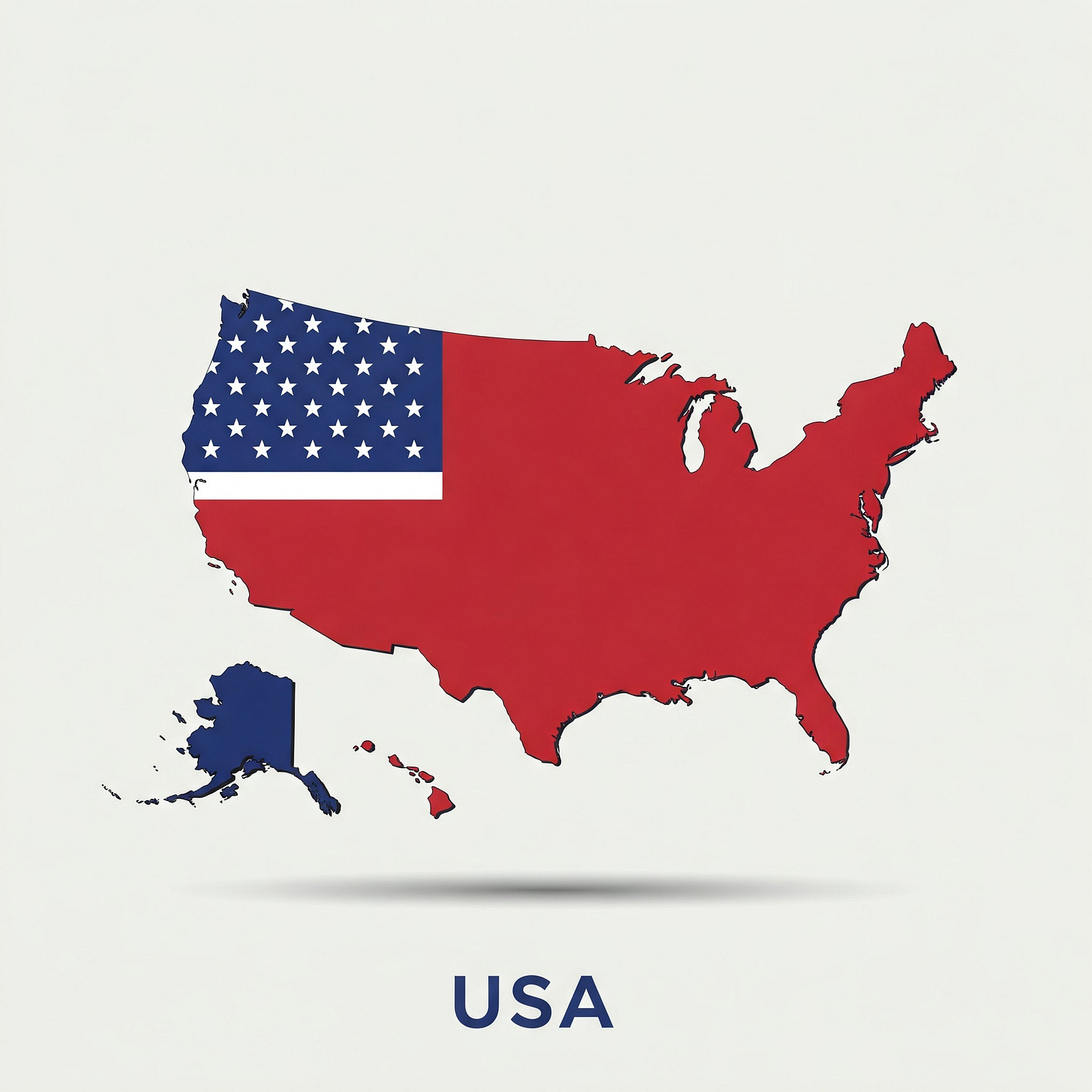Racial Composition of the U.S. (Aggregate Genetics) Predicts Political Preferences & Voting Patterns
My hypothesis: racial demographics roughly predict political preferences & voting patterns, on average, in the U.S.
I’m a strong believer in the idea that “demographics is destiny.” What I mean is that a country’s aggregate genetic makeup determines its success (advancement and/or innovation) or failure (stagnation and/or decline).
In democratic countries, if you give everyone the right to vote, broader voting trends become fairly predictable based on racial composition of the country — and to some extent, the percentage (%) of citizens subject to selection effects.
How did I form this hypothesis? Observation. Just look at how policies have shifted downstream of demographics in the U.S., E.U., Canada, and other democratic countries that rapidly give voting rights to new immigrants.
I think we can, on average, predict how certain racial groups are likely to vote (voter preferences), and I think this is a byproduct of genetics (regardless of whether you want to believe it).
Why? Most new immigrants in U.S. are predominantly hispanic (i.e. “latino”) from Mexico, Central America, and South America. These countries tend to have socialist and/or communist-leaning policies… and these hispanic immigrants tend to vote overwhelmingly for Democrats (i.e. Liberals, Progressives, etc.) in U.S. elections.
This does NOT mean that “ALL HISPANICS VOTE DEMOCRAT.” We know that there are enclaves of say Vietnamese and Cubans who fled Vietnam and Cuba as a result of communism and are strongly anti-communism… but I’d argue this is a selection effect of a small % from Vietnam and Cuba — and these don’t make up most immigrants in the U.S.
A simple microcosm to study is California. California was historically a Republican stronghold (aligned with original American ethos of free market capitalism, freedoms, low regulation, etc.) — and now it’s become arguably the most leftist state there is.
Historically the U.S. was essentially founded/built by mostly highly self-selected White European immigrants. In other words, these Whites were NOT your average Europeans… they believed in individual liberty, personal responsibility, law & order, small government, low taxes, free markets, and capitalism.
When they arrived in the U.S. — there was zero welfare state. They busted their asses to build the country up from nothing… Native Americans (i.e. Indians) were mostly just murdering and pillaging each other and weren’t “building up a country.”
The original American ethos is what originally “Made America Great.” You either figured out how to make it in America, or you didn’t… there was no generous welfare state, free healthcare, etc. These days? There is a generous welfare state — including things like: housing, loans, healthcare, food stamps, etc.
Lack of border enforcement has lured immigrants from the likes of Mexico, Central America, and South America to flee dysfunctional (often socialistic, communistic, low freedom) countries to the U.S. — and can you blame them? I would do the same thing in their shoes. They get a lot of free stuff in the U.S., find jobs, and have a fast-track to citizenship.
From 2020-2024, Joe Biden’s administration actively prevented border security from doing its job (i.e. blocking illegal entrants) and found ways to import illegals and asylum seekers (e.g. Haitians in Ohio) without approval of the American public.
There was even a free app that the U.S. gov made wherein non-citizens could sign up and book a flight for free (on the U.S. government’s dime) to anywhere in the U.S. (even using fake identification).
Funny enough, many “asylum seekers” would regularly use welfare and/or benefits from the U.S. to “vacation” back to their homelands (native countries). Imagine that… suddenly the country from which they need “asylum” becomes a hot vacation spot within 1-2 years of arrival (annual trips back).
Many of these individuals got citizenship easily or had anchor babies to ensure deportation would be difficult. Entire industries (e.g. NGOs, lawyers, charities) worked to help these immigrants stay in the U.S., avoid deportation, and become citizens. This is part of the reason you see “sanctuary cities” in various places in the U.S.
What’s the problem with immigration? Nothing. However, when you have UNFILTERED ILLEGAL IMMIGRATION plus a generous welfare state — it incentivizes people to flock in droves to the U.S. and become a parasitic underclass (leeching off the government).
Eventually many illegals become citizens and inevitably VOTE AGAINST THE ORIGINAL ETHOS that originally “made America great” (building it from nothing). And I don’t even think they are intentionally voting for the destruction of America — I think they’re just trying to do the right thing.
But my hypothesis is that voting patterns are probably genetic — hence the predictable voting averages between racial groups. These are not driven by a single gene, but by tiny differences in potentially thousands of genes between racial groups.
I’ll acknowledge that “race” is in fact a social construct — but it serves as a proxy for “genetic clusters” (shaped by evolution). This does NOT mean that all individuals from a certain race X-Y-Z have the same preferences.
I still expect a percentage of non-Whites (Hispanics, Blacks, Asians) to have genetic combos that favor the OG American ethos… but it’s not the majority. Just like I expect many Whites to have genetic combos that favor anti-OG American ideals — but it’s not the majority.
On average, I expect a majority of individuals from specific races to vote specific ways if there is minimal/no selection effect (like we originally had with earliest settler Whites in the U.S.).
A fairly comical “debunk” of this racial demographic voting patterns that I see thrown around is something like: Hispanics won 2024 for Trump — and look at Cubans and Vietnamese — they hate communism and socialism after fleeing their countries.
My response to this? Trump did historically great with Hispanics BUT if the election were decided by Hispanics alone, Kamala Harris would’ve obliterated Trump (Hispanics, like all non-White voting blocs, voted under 50% for Trump). Whites were the only racial cohort voting over 50% for Trump.
As far as Cubans and Vietnamese go, they are a tiny % of immigrants in the U.S. (not enough to have any meaningful impact on major elections)… and those that made it to the U.S. are selected for (fled because they hated policies in the homeland). If you’d suddenly incentivized average Cubans and/or Vietnamese to enter the U.S. - you’d likely get voting patterns observed in their native lands.
I. Hypothesis: Racial Composition Predicts Political Preferences & Voting Outcomes in the U.S. (Capitalist vs. Socialist)
My hypothesis: Racial composition of the U.S. predicts voting outcomes (alignment with original “American ethos” vs. “socialist drift”) — driven by underlying genetic predispositions that differ slightly between groups.
Racial composition is a proxy for genetic clusters
Each cluster has subtle genetic predispositions (on avg.) influencing cognition & behaviors (e.g. collectivism vs. individualism)
As racial composition shifts in the U.S. — especially via unfiltered immigration without selection mechanisms (e.g. strict assimilation, absence of welfare, restricted voting rights, delayed citizenship) — the overall electorate moves politically toward policies reflecting the avg. genetic preferences of the new groups.
I’m a strong believer that demographics (and thus genetics) are destiny. In “democratic” countries, if you grant universal suffrage without meaningful selective filters—such as restricted welfare access or stringent immigration standards—you inevitably shape political outcomes by influencing the population's genetic makeup.
My thesis contends that, given enough people flowing in unfiltered, we naturally enable the manifestation of underlying genetic tendencies in political preferences.
Specifically, the central hypothesis here is that genetic factors—rather than purely cultural, economic, or IQ-based considerations—play a major and measurable role in shaping the political inclinations of various groups.
This is not about a single “political gene.” Rather, it's the cumulative influence of many tiny genetic differences in traits like:
Social trust
Risk tolerance
Preference for hierarchy vs. egalitarianism
Comfort with authority and centralized control
Willingness to accept communal resource distribution or welfare-based solutions
Even tiny average differences across these traits (e.g. 0.1%-5%) within populations can decisively tip the scale in a two-party system—leading to consistent and significant electoral outcomes.
1. Genetic Influence Mechanism
Genetic variation shapes personality traits, such as:
Risk tolerance: Higher inclination toward independence or self-reliance versus preference for social safety nets and welfare programs.
Social trust: Affects support for communal resource-sharing structures, welfare states, and collectivist redistribution of resources.
Deference to authority: Groups genetically inclined toward accepting hierarchical or collectivist social structures will more likely support bigger government intervention and regulation.
For example, populations slightly predisposed to communal cooperation or egalitarian resource distribution consistently favor parties promising expanded welfare and social justice reforms.
Over decades, influxes or growth of groups with collectivist-prone genetic traits cumulatively reshape the political ethos of a country like the U.S.
2. IQ is NOT the Driving Factor
Contrary to popular belief, high intelligence (IQ) does not inherently correlate with pro-capitalist or minimal-government political orientations:
High-IQ Immigrant Groups (particularly certain Asian-American communities) typically favor Democratic candidates, endorsing expanded social welfare, despite being economically successful.
Such data strongly indicate that deeper genetic or cultural predispositions toward accepting collectivist or state-led solutions are separate from intelligence.
This explains why highly educated or economically successful immigrants from collectivist-oriented societies maintain their progressive voting patterns even after assimilation.
3. Demographic Composition as Destiny (with Selection Effects)
Population genetics shift via birth rates and immigration patterns, altering the electorate’s average genetic makeup over generations.
Large-scale immigration from regions historically comfortable with socialism or collectivism (e.g., Latin America, parts of Asia, Africa, modern Europe) incrementally erodes America’s traditional “frontier ethos.”
Without a deliberate selection mechanism or filter (e.g., zero welfare, no immediate citizenship, restricted voting), immigrants self-select for generosity of the welfare state and opportunities, effectively attracting populations inclined toward collectivist solutions.
Subgroup Selection Effects:
Some subgroups deviate from overall racial or ethnic voting patterns due to self-selection.
Cuban Americans fleeing communism lean Republican, reflecting anti-communist cultural/genetic selection.
Vietnamese immigrants, many fleeing communism, also favor Republicans for similar reasons.
Nigerian and Indian professionals, often entrepreneurial, might lean pro-market due to selection for independence and economic freedom.
However, these subgroups are relatively small compared to the overall immigrant population. Broad immigration from predominantly collectivist or socialist regions—without rigorous selective filters—still pushes overall national voting averages leftward.
Reality: Without deliberate, rigorous selection mechanisms (e.g., strict immigration criteria, limited welfare state policies, delayed citizenship, or limited voting rights), the U.S. inevitably becomes a magnet for genetically predisposed collectivist-oriented individuals. Over time, this shifts America's political landscape away from its founding principles—minimal government, strong policing, personal responsibility, and a robust free-market ethos—toward progressively socialist or collectivist ideals. Thus, America’s original ethos erodes, driven directly and indirectly by demographic and genetic change.
II. Historical American Political Parties & the “Original Ethos” of the U.S. (Made America Great)
1.) 19th Century Foundations: Genetic Self-Selection on the Frontier
Early Frontier Gene Pool
Pioneers & Settlers: In the 1800s, many Americans or new arrivals were bold risk-takers crossing oceans/continents for personal opportunity. The thesis suggests these individuals often carried genetic traits favoring independence and mistrust of strong central authority.
Population Composition: Predominantly Northwestern Europeans (Britain, Ireland, Germany, Scandinavia). The logistical and financial difficulty of migrating served as a natural filter, favoring the adventurous and self-reliant.
Classical Liberal (Market-Oriented) Politics
Low Government Intervention: A product of this risk-taking gene pool’s innate suspicion of centralized rule, manifested in minimal taxation/welfare.
Strong Private Property Rights, Individual Liberty: Welfare systems were nearly nonexistent. Neighbors often assisted each other, but large federal programs were absent.
High Productivity & Innovation: The “frontier spirit” spurred rapid development of railroads, telegraphs, mechanized farming, etc. From the genetic perspective, adventurous and inventive personalities thrived, reinforcing a self-sustaining cycle of minimal-state capitalism.
Assimilationist Immigration Policies
Open Door, But Harsh Frontier: Few formal entry restrictions compared to modern standards, but assimilation was expected.
Selection Filters: While immigration was not heavily regulated, only those with sufficient determination (and who could handle the challenges) stayed long-term. This favored a homogenous population championing pro-limited-state attitudes.
2.) Mid-20th Century (New Deal to Civil Rights)
New Deal Expansions
1930s: The Great Depression led to increased federal involvement (Social Security, work programs), partially deviating from minimalism.
Comparison to Europe: Still modest relative to full-scale European welfare states—indicating the genetic predisposition to capitalism and smaller government persisted.
Population & Racial Breakdown
White Majority (~85–90%) dominated, with a smaller Black minority.
Immigration from non-European sources remained limited, maintaining a broad continuity of the gene pool from the 19th century.
Civil Rights & Realignment
Demographic Shifts: Black Americans moved from rural South to industrial urban centers, reshaping local voting but not drastically altering the nationwide “frontier stock.”
Seeds for Bigger Government: Civil rights legislation expanded federal power to tackle social inequalities. Yet, both parties still largely supported capitalism, national defense, and personal responsibility.
Lasting Core Values
1950s–1970s: The typical American voter (white or Black) espoused strong patriotism, belief in free enterprise, and self-reliance—reflecting a minimal “collectivist gene” infiltration.
3.) Late 20th–21st Century: Democratic “Wokeness” vs. Republican Traditionalism
Democratic Party
1970s Onward: Pushed broader welfare, more regulatory oversight, and inclusive “multiculturalism.”
Woke Agendas (2010s+): Emphasis on identity politics, expanded immigration, lenient criminal justice. In the genetic view, they attract or represent a rising population predisposed to bigger-state solutions.
Composition Changes: Post-1965 Immigration and Nationality Act ended origin quotas, welcoming more arrivals from Asia, Latin America, Africa—regions with historically collectivist norms.
Illegal Immigration: Partial tolerance, minimal enforcement, adding further collectivist-leaning groups to the population.
Republican Party
Retains the Frontier Ethos: Advocates small government, low taxes, tough policing, skepticism of entitlements—reflecting older gene pool traditions.
Nationalist Rhetoric (Trump era): Aimed at protecting jobs, controlling borders, and resisting the shift in America’s genetic/cultural composition away from the frontier ethos.
Modern European Immigration
Robust Welfare States in Europe produce “white” immigrants not necessarily aligned with the 19th-century self-reliant gene stock. Many accept universal healthcare or progressive taxation as normal.
Effect on Productivity/Growth
As more collectivist or socialist-leaning immigrants arrive, critics (within this thesis) argue risk-taking and entrepreneurial zeal might wane eventually.
Contrastingly, America remains an innovation leader in many fields—though long-run genetic shifts may hamper or transform that dynamic.
Defining the “Original American Ethos” via a Genetic Lens
Minimal Government: Reflective of populations genetically inclined toward autonomy.
Strong Law & Order: Possibly tied to conscientious, assertive traits that favor strict policing.
Self-Reliance: Genes tied to risk tolerance and independence.
Changing Selection Filters: Post-1965 policies, chain migration, and lax border enforcement reduce the “pioneer-type” advantage in the U.S. gene pool, infusing more collectivist predispositions.
III. Demographic Shifts (2000–2025+)
1. Population Growth & Racial Composition
Overall Expansion: From ~281M in 2000 to ~331M in 2020 (+50M).
Whites: Fell from ~69% to ~58%, reflecting a major decline in the historically dominant gene pool.
Hispanics: Jumped from ~12.6% to ~18.7%, likely surpassing 20% in 2025. Many come from Latin American societies with populist or socialist histories.
Asians: Grew from 3.6% to 5.9%; though often high-IQ, they lean Democrat, suggesting deeper communal or hierarchical dispositions.
Blacks: ~13% relatively stable. Smaller portion (~8% of new immigrants). Additional diversity—particularly from post-colonial statist regimes—adds to collectivist lean.
2. Birth Rates & Median Ages
White Fertility: Below replacement (~1.6–1.8), steadily lowering their share in the upcoming generation.
Minority Fertility: Near or above replacement (≥2.0), along with younger median ages (often 5–7 years below the U.S. median). This accelerates the replacement effect in the electorate.
3. Immigration Sources & Patterns
Latin America (~44%): Mexico, Central & South America. Culturally more communal or populist.
Asia (~27%): India, China, Philippines, where state-driven development models are common.
Africa (~8%): Many from strong central governments or post-colonial frameworks.
Modern Europe: Welfare-state norms. No guarantee of free-market or minimal-state acceptance.
4. Future Projections & Macro Trends
Continued Hispanic and Asian Growth: Likely to expand further, driven by consistent immigration and relatively higher fertility rates compared to whites.
Further White Decline: Expected to continue as low fertility and aging reduce their share, gradually approaching minority status within several decades.
Political Implications: This demographic shift likely reinforces progressive policies and communal orientations, reshaping electoral dynamics significantly in urban and Sunbelt states.
5. Geographic & Political Ramifications
Sun Belt Shifts: Texas, Florida, Arizona, etc., receiving large minority inflows, trending purple/blue.
Urban vs. Rural: Immigrants often cluster in cities, reinforcing progressive policies in metropolitan areas. Rural white (old-stock) populations see diminishing statewide influence.
Net Effect (2025): A profoundly diverse profile, with a rising majority of collectivist-leaning groups (by genetic disposition). This helps explain the electorate’s gradual drift away from the frontier ethos.
IV. Voting Patterns by Race, Turnout, Preferences
Elections are becoming more predictable with demographic shifts. Had the Democrats not ran Kamala Harris and embraced overly/extreme woke polices prematurely in 2024 and/or not gone up against the larger-than-life Donald Trump — they probably would’ve had a layup win.
1. General Voting Preferences (Recent Elections)
These patterns are stable over multiple election cycles, confirming consistent group predispositions.
Whites: ~55–60% GOP, especially among non-college/rural.
Blacks: ~80–90% Democratic.
Hispanics: ~60–70% Democratic, with small GOP gains among certain subgroups.
Asians: ~60–70% Democratic (reinforcing non-IQ-based collectivist lean).
2. Turnout Patterns
2016: White turnout ~65%, Black ~59–60%, Hispanic/Asian <50%.
2020: White turnout ~71%, Black ~63%, Hispanic ~54%, Asian ~60%.
2024: Exit polls suggest minor increases for GOP among minority men, but Democratic majorities remain intact in each group.
3. Electorate Composition
White voters fell from ~73% (2012) to ~69–70% (2020). Projections show ~58–60% by 2028.
Minority turnout is rising, narrowing the gap. Younger, diverse cohorts strongly favor progressive/welfare policies.
4. Policy Preferences
Social Welfare/Big Government: Over half of Hispanic, Asian, and ~80–90% of Black voters support expansions in healthcare, education, etc.
Immigration & Criminal Justice: Typically prefer lenient or humanitarian immigration policies, sentencing reforms—contrasting with the tough assimilation stance of old.
5. Selection Effects & Outliers
These subsets highlight within-group selection for free-market or anti-communist leanings, but do not reverse the broader collectivist tilt of their larger ethnic categories.
If you had ZERO welfare state, you’d increase selection only for those who would be willing to work hard & compete in the free market… but we are far from that.
Cubans: Historically anti-communist, more Republican.
Vietnamese Refugees: Anti-communist origins.
Nigerian Entrepreneurs: Some may be strongly capitalist.
V. Real-World Alignment vs. My Racial Composition Thesis
1. Real-World Voting Patterns & Genetic Predictions
Hispanics (60–70% Democratic): Historically consistent voting for collectivist/socialist-leaning policies aligns directly with genetic predictions, considering most originate from nations with populist or socialist governance structures.
Asian Americans (65–75% Democratic): Despite higher IQ and incomes, Asians reliably vote Democratic, reinforcing the thesis claim that underlying genetic/cultural predispositions outweigh intelligence alone in shaping policy preferences.
Black Americans (80–90% Democratic): Strong, unwavering Democratic loyalty supports the thesis’s assertion of genetically or deeply-rooted collectivist policy preferences independent of socioeconomic status.
Modern European Immigrants: Arriving primarily from welfare-heavy societies (Scandinavia, Germany, UK), these immigrants also tend toward collectivist voting despite their high education or incomes—consistent with genetic/cultural predispositions rather than IQ-based explanations.
Quantified Alignment: Approximately 80–90% consistency between observed demographic voting data and genetic thesis predictions.
2. Importance of Selection Filters & Exceptions
Cuban Americans: Demonstrate how selection effects alter genetic/cultural averages significantly, as refugees fleeing communist regimes carry genetic predispositions favoring individualism and anti-communism—illustrating clearly how powerful selection effects can be.
Implication: In absence of intentional selection filters (e.g., eliminating welfare incentives or enforcing ideological assimilation), demographic voting averages revert strongly to collectivist preferences predicted by genetic/cultural heritage.
Logical Takeaway
Real-world U.S. election data provides compelling empirical support for the thesis:
Overall alignment: Estimated at 80–90% accuracy, with consistent electoral trends validating the genetic-demographic prediction model, particularly absent selective filtering measures.
Selection effects demonstrably influence subgroup deviations (Vietnamese, Cubans), further confirming that broad demographic shifts (without selection effects) strongly shape voting outcomes.
Empirical Fit: Real-world evidence strongly supports the genetic-demographic thesis: In the absence of explicit selection filters, demographic composition reliably predicts electoral preferences and thus policy outcomes in the United States.
VI. Why More “White” Immigration Won’t Save the American Ethos
Many erroneously think “more whites” will save the OG American ethos… but I am highly skeptical of this. In fact, I think “more whites” is extremely unlikely… you need some sort of “filter” for them here… really anyone could come to the U.S. if you cut all welfare, cracked down extremely hard on crime, and didn’t give everyone rapid “fast-track” citizenship or voting rights.
Modern European Welfare Norms
Europeans from universal healthcare, high-tax countries are often comfortable with strong state interventions—at odds with the 19th-century frontier distrust of authority.
Despite being “white,” they bring collectivist or social-democratic leanings, reinforcing the progressive majority.
19th-Century Self-Selection vs. 2025
Old White Immigrants: Fled feudal or monarchical structures, forging a strongly independent, anti-government gene pool in America’s frontier era.
Modern White Immigrants: From stable welfare states in Europe, not necessarily carrying the same risk-taking or anti-state DNA.
Result: The net injection of modern European “white” genes does not replicate the original American ethos.
IQ/Education Levels Irrelevant
Many highly educated Europeans still favor big-government ideas.
This underscores the theme that genetic predisposition > IQ in shaping the acceptance of state paternalism.
Overall: Simply expanding “white” immigration from Europe does not restore a frontier-like gene pool. Instead, it may further push American politics left, culminating in a more “European-style” welfare orientation.
VII. Modern Political Parties (Democrats & Republicans): Degree of Alignment with Original American Ethos
1. What is the OG “American Ethos”?
This is what led America to becoming the most dominant country on Earth — and the top “superpower.” It built the country from nothing into the place everyone wants (or at one point wanted) to be.
Minimal Government: Low taxes, limited federal welfare, deep skepticism of paternalistic governance.
Strong Law & Order: Firm policing, robust sentencing, high respect for military and police.
Individual Responsibility: Cultural embrace of self-reliance, bootstrapping.
Controlled/Assimilationist Immigration: Expecting newcomers to conform to the “frontier mentality” of self-sufficiency.
2. Republican Party 2025 (~60–70% Aligned)
Economic Policies: Typically advocates lower taxes, deregulation, and limited welfare expansions. This resonates with the old frontier stance of minimal state interference in personal economic endeavors.
Law Enforcement: “Tough on crime,” zero tolerance for illegal immigration—supports the original ethos of self-discipline and moral order.
Immigration Outlook: Emphasis on strict border controls, skill-based legal entry, and assimilation—mirroring historical selection for self-reliant newcomers.
Populist Variations: Certain populist measures (e.g., tariffs, “America First” trade policies) deviate from classical free-market ideals.
Overall: In 2025, Republicans remain far closer to the original American ethos than Democrats.
3. Democratic Party 2025 (~10–20% Aligned)
Economic & Welfare Policies: Expanded welfare, progressive taxation, larger federal programs—contrary to the minimal-state principle.
Criminal Justice & Identity Politics: Support for reforms seen as lenient on crime, focus on “diversity, equity, inclusion,” and broad civil-rights expansions that often challenge traditional assimilation frameworks.
Immigration Stance: Pro-amnesty, more open borders, acceptance of cultural pluralism over strict assimilation—bringing in populations with collectivist leanings.
Overall: The net effect is a big-government orientation that stands in stark contrast to the self-reliant, low-state frontier tradition.
4. Racial/Genetic Thesis Angle
GOP as Frontier-Stock Champion: Republicans tap into the older gene pool favoring autonomy and skepticism of big government.
Democrats Represent Emerging Collectivist Populations: Immigrant groups from socialist/statist regions, plus younger generations with egalitarian instincts, reinforce Democrats’ tilt away from the original ethos.
5. Intraparty Variations
Republicans: Libertarians (pure minimal-state) vs. populists (occasionally favoring protectionism).
Democrats: Moderates (accept some capitalism) vs. left-progressives (strong collectivist push).
Overall: The macro-level difference remains limited-state vs. big-state.
VIII. The Future of America: 2028, 2032, 2036, 2040+
Based on demographic changes in the U.S. as a result of: illegal immigration, legal immigration, birth rates, etc. — I expect the Democratic party to retain a pronounced advantage in all future elections.
I think the Democrats had a substantial advantage in 2024… but they went up against the big shot Donald Trump and ran the worst possible candidate after gaslighting the public that Joe Biden had zero cognitive decline until last minute.
The only exception would be if a massive baby boom occurred among White Americans (unlikely) and/or zero additional immigration occurred coupled with anti-aging technology (such that people could live forever).
1. Demographics as a Tipping Point
White share of eligible voters may drop to ~58–60% by 2028, ~55–57% by 2032.
Minority blocs—Hispanic, Black, Asian—consistently ~60–90% Democratic, thereby creating a structural advantage for big-government platforms.
2. Electoral Arithmetic
Even with modest gains among minority men for the GOP, high minority turnout plus a portion of liberal whites can yield a stable left majority in popular-vote outcomes.
GOP can sometimes contend via Electoral College strategies, but overall, the drift is leftward.
3. Potential Realignments
Assimilation or Outreach: Republicans might recruit entrepreneurial or religious subgroups within Hispanic/Black/Asian communities, but the genetic thesis posits deep-rooted communal instincts are slow to shift.
Democratic Moderation: If Democrats see large swaths of immigrant communities comfortable with big-state solutions, they might not move to the center—thus reinforcing progressive platforms.
4. State-Level Transformations
Texas: A longtime GOP bastion could become purple/blue if demographic changes (urban Hispanic/Asian voters) continue.
Arizona, Georgia, North Carolina: Already near tipping, with diverse suburbs flipping them.
California: Stands as the archetype—once competitive, now dominantly Democratic due to demographic realignment.
5. Annexation of Canada
There have been recent talks entertaining the idea that the U.S. should annex Canada… although this would be economically beneficial in many ways, it would shift the political landscape leftward at an accelerated rate if the annexed Canadians obtained voting rights.
If the U.S. Ever Annexes Canada, it would absorb ~38 million people (many concentrated in urban centers, strongly supporting universal healthcare, welfare policies).
Effect: This would further tilt the demographic and cultural gene pool toward collectivist norms, cementing a decisive left majority.
From the viewpoint of the original ethos, Canada’s population—already comfortable with single-payer healthcare—would overshadow conservative enclaves in the U.S.
IX. Case Study: California as a Microcosm of the Racial, Genetic Preference, Political Shift
1. Historical Context: California’s Original Political Balance (1950–1980)
Mid-20th Century Dominance of "Frontier Ethos":
California was historically competitive, often leaning Republican or centrist. Ronald Reagan served as governor (1967–1975), epitomizing minimal government, tough law enforcement, free markets, and pro-business policies.
Demographic Composition (1970): Approximately 77% Non-Hispanic White, 12% Hispanic, 7% Black, 3% Asian.
Economic and Cultural Landscape:
A major hub for aerospace, defense, agriculture, manufacturing, and innovation.
Entrepreneurial drive thrived under center-right governance, lower taxation, and a robust military-industrial complex.
2. Demographic Transformations (1980–2000): Massive Immigration Wave
Immigration Surge:
Post-1965 immigration reforms led to significant inflows from Mexico, Central America, and Asia.
High levels of illegal immigration, especially from Mexico, reinforced progressive voting patterns and collectivist attitudes, given immigrants’ origins from socialist or populist-leaning societies.
Population Shifts (1980–2000):
Non-Hispanic White share dropped significantly:
1980: ~66% White (Non-Hispanic), 19% Hispanic, 8% Black, 5% Asian
2000: ~47% White (Non-Hispanic), 32% Hispanic, 7% Black, 11% Asian
Hispanics overtook Blacks as the largest minority group and soon approached a demographic majority in several regions.
Impact on the "Genetic Pool":
Consistent immigration from collectivist-leaning regions significantly tilted California’s electorate towards progressive policies.
Younger, diverse generations further solidified progressive majorities, confirming the genetic-cultural hypothesis.
3. Further Demographic Shifts (2000–2020): Solidifying Collectivist Majority
Accelerating Non-White Majority:
Continued demographic realignment toward Hispanic and Asian populations:
2000: 47% Non-Hispanic White, 32% Hispanic, 11% Asian
2010: 40% Non-Hispanic White, 38% Hispanic, 13% Asian
2020: ~35% Non-Hispanic White, ~39% Hispanic, ~16% Asian
California officially became a "majority-minority" state, with Non-Hispanic Whites dropping below 40%, solidifying progressive political dominance.
Political Consequences:
Republicans became uncompetitive statewide, increasingly losing urban/suburban regions.
Demographic shifts entrenched an enduring progressive majority favoring large-scale welfare programs, lenient immigration policies, and expansive government intervention.
Political Realignments and Key Elections (1990–2020)
1990s Tipping Point:
Governor Pete Wilson (R, 1991–1999) championed Proposition 187 to curb illegal immigration, causing lasting alienation among rapidly growing Hispanic and Asian electorates.
Subsequent backlash permanently aligned these demographic groups (60–70%+ Democratic) against GOP policies.
Early 2000s: From Schwarzenegger to Irreversible Leftward Shift
Arnold Schwarzenegger (R, 2003–2011) governed as a centrist/moderate, reflecting California’s changing electorate.
After Schwarzenegger, Republicans effectively ceased winning major statewide offices, as progressive coalitions dominated.
Present Day (2020+):
Democrats secure ~60–65% of presidential votes; hold legislative supermajorities.
Original "Reagan Country" replaced entirely by progressive governance emphasizing expansive welfare, environmental regulation, identity politics, and lenient law enforcement.
“Woke” Policies, Big Government, Erosion of the Frontier Ethos
High Taxes and Expansive Welfare:
California leads with extremely progressive taxation, heavy welfare spending (homelessness, healthcare expansions), and social programs.
Under the genetic thesis, the progressive demographic majority naturally favors larger government despite economic drawbacks (e.g., high taxation, cost-of-living increases).
Lenient Criminal Justice Policies:
Progressive reforms (e.g., Proposition 47, reduction of felonies) drastically weakened punitive policing, aligning with the collectivist tendency towards rehabilitation rather than law-and-order.
Identity Politics and Immigration Policies:
California is a sanctuary state, actively protecting undocumented immigrants, with substantial funding for diversity, equity, and inclusion initiatives.
Policies resonate strongly with the progressive electorate’s genetic-cultural predisposition toward collectivist values.
Economic & Innovation Paradox?
California has a lot of “success” due to establishment of mega-cap tech companies, Hollywood, large sports markets, pristine weather, etc. In the past it was the place that was “cool” in the U.S. These days it is mostly successful in spite of its extreme left-wing, hyper-woke, socialist/communist policies.
Historic Business Success vs. Current Regulatory Environment: California’s economic dominance (Silicon Valley, Hollywood, agriculture) began largely before the current progressive regulatory regime took hold (pre-2000). Many companies succeeded due to historic momentum, ideal weather, large cities, robust talent pools, and venture capital, despite—not because of—current high-tax, regulatory-heavy governance.
Innovation Amidst Collectivism: California remains a global tech leader, yet innovation increasingly struggles against heavy regulations, housing crises, and high living costs, causing an exodus of businesses and individuals to states better aligned with the original American ethos (e.g., Texas, Florida).
Filtering Effect: Those leaving are predominantly individuals or businesses with minimal-state preferences, further concentrating California’s collectivist demographic alignment and voting patterns.
Why California Demonstrates my Racial Composition = Politics Thesis Clearly
Mass Immigration and Demographic Change: Immigration (legal and illegal) overwhelmingly from collectivist-leaning countries drastically shifted California’s genetic-cultural composition. Hispanic/Asian voting preferences (~60–70% Democratic), combined with progressive whites, decisively outnumbered frontier-leaning conservatives.
Institutionalization of Progressive Policies: Once collectivist voters attained electoral dominance, they legislated a permanent shift toward welfare expansions, identity politics, lenient law enforcement, and enabling further illegal unvetted immigration.
Irreversibility and “Escape Velocity”: Republicans now face near-impossible electoral challenges statewide. California’s shift is effectively irreversible—illustrating the "escape velocity" concept of genetic-cultural political drift clearly at a state level.
Lessons for the Entire U.S.
California as a National Preview: The demographic transformation (1980–2020) prefigures America’s potential trajectory by 2030–2050, if demographic trends continue without robust selection filters (e.g., strict immigration controls, limited welfare).
Innovation and Welfare Coexist Temporarily: The California paradox shows that advanced tech sectors initially thrive despite collectivist policies, but sustainability is uncertain. Long-term effects could mirror economic stagnation or business exodus.
Future of America: "America in Name Only": Without significant policy shifts or demographic selection mechanisms, California’s political and cultural trajectory could foreshadow America’s future—an economically powerful yet progressively dominated state, with the original American ethos relegated to pockets, enclaves, or historical nostalgia.
Risk of Long-Term Decline: If AI/automation does not adequately compensate for economic inefficiencies under a progressive welfare-heavy regime, the U.S. might increasingly resemble nations characterized by wealth inequality, high crime, and social polarization—e.g., Brazil or South Africa.
X. Hypothetical Methods to Preserve the Original American Ethos (that “Made America Great”)
Random ideas… probably the best would be restricting voting rights to net positive lifetime taxpayers. However, it’s unlikely to ever pass as a law… it is feasible, but people would argue it too crazily.
1. Restricting Voting Rights
Net-Lifetime Positive Taxpayers: Voting restricted solely to citizens who pay more in taxes than they receive from government benefits.
Effectiveness: High, directly aligns voter interests with minimal government.
Challenges: Significant constitutional, ethical, and political hurdles; potential for extreme public backlash.
2. Ideologically Filtered Immigration
Merit and Ideological Vetting: Only immigrants demonstrating strong alignment with free-market capitalism and self-reliance allowed entry.
Effectiveness: High, proactively shapes future electorate.
Challenges: Difficult enforcement, accusations of discrimination, subjective criteria for ideological alignment.
3. Eliminating or Heavily Restricting Welfare
Policy: Deny access to welfare programs (Medicaid, SNAP, TANF) especially for all noncitizens, thus discouraging collectivist-oriented migrants.
Effectiveness: Moderate-to-high, self-selects immigrants compatible with minimal government ethos.
Challenges: Ethical opposition, legal complexities, and logistical enforcement concerns.
4. Constitutional Amendments (“Superlaws”)
Strategy: Permanently enshrine minimal government, low-tax, and welfare-limiting policies via constitutional amendments.
Effectiveness: Moderate, provides lasting legal guardrails.
Challenges: Requires supermajorities; increasingly unrealistic due to demographic shifts favoring collectivist voters.
5. Peaceful Secession or New Country Formation
Proposal: States or regions strongly committed to original American values peacefully exit to form new political entities.
Effectiveness: Potentially high, provides absolute preservation for breakaway regions.
Challenges: Enormous constitutional, logistical, and political resistance; practical implementation difficulties.
6. Radical Technological Advancement (AI & Robotics)
Approach: Accelerate AI and robotics to sustain economic growth despite socialist policy drift; mitigate negative impacts of collectivism.
Effectiveness: Uncertain/moderate, contingent on AI capability and uncensored operation based on first principles.
Challenges: Requires safeguarding AI freedom from ideological censorship; risk of insufficient or delayed technological development.
7. Radical Biomedical Advancement (Cure Aging)
Proposal: Drastically slow or reverse aging to maintain electorate stability, potentially preserving traditional ethos longer.
Effectiveness: Highly speculative, long-term strategy with uncertain political effects.
Challenges: Technological feasibility uncertain; delayed impact; demographic shifts may already have reached critical tipping point.
Note: The U.S. should also opt to AVOID annexation of Canada (unless you somehow block voting rights for annexed Canadians). This will just accelerate the decline of America. If a “socialist tipping point” is crossed in the U.S. — then annexation of Canada makes sense.
XI. Which countries will U.S. most resemble in the future if this genetic/policy drift continues?
A.) Primary Scenario (60%): Brazil-Like Path
Characteristics: Multiethnic democracy, expansive social programs, persistent inequality, high crime rates.
Rationale: The U.S. trajectory matches Brazil's demographic diversity, large welfare expansion, entrenched inequality, and social division despite high public spending.
B.) Secondary Scenario (20%): South Africa-Like Path
Characteristics: Intensified racial identity politics, aggressive equity policies, weakened law enforcement, increased crime, institutional erosion.
Rationale: Growing racial tensions and strong institutionalized identity politics could erode American stability similarly.
C.) Tertiary Scenario (10%): European Welfare-State Model (France/Germany)
Characteristics: High taxes, robust welfare systems, universal healthcare, moderate growth.
Rationale: Less probable given America’s larger scale and deeper racial tensions; potential if institutions remain stable amid increasing collectivism.
D.) Quaternary Scenario (5%): Canada-Like Liberal Democracy (via Annexation or Cultural Convergence)
Characteristics: Strong social programs with moderate political tension and cultural integration.
Rationale: Requires major geopolitical shifts (annexation) or exceptional integration unlikely at America's scale.
E.) Hybrid Scenario (10%): AI-Driven Prosperity Amid Socialist Shift
Characteristics: AI/robotics maintain high productivity funding generous welfare, limiting economic decline despite loss of original ethos.
Rationale: Relies on ideal AI innovation timing coinciding with policy drift. Potentially optimistic if AI remains uncensored and innovative.
Overall: The U.S. is most likely (~60%) heading toward a Brazilian-style future, with significant racial divisions, welfare expansion, and socioeconomic stratification. South Africa’s instability or Europe's welfare-state structures are plausible but less likely. AI could mitigate these outcomes, but only under ideal conditions.
XII. Projected “Socialist Tipping Point”: From Soft Drift to Permanent Majority
I should note that “Republicans” can still compete and win in elections in 2028, 2032, 2036, 2040, etc. — but they probably will need to retool their stances/policies.
Retooling policies to make the Republican party more competitive will likely involve massive shifts away from the OG “American Ethos.”
So sure Republicans can win, but the American “ethos” or tenets that “made America great” will continue eroding.
“Escape Velocity” Concept
Once progressives surpass ~50% consistently, big-government policies can embed themselves irreversibly (via judiciary, bureaucracy).
No Turning Back: A “point of no return” emerges where conservative or classical liberal ideologies are relegated to a permanent minority.
Timeline & Demographic Milestones
2028 (~60% White Electorate): Likely a ~3–6% popular-vote edge for Democrats; Republicans can compete but are disadvantaged.
2032 (~55–57% White Electorate): Progressive stronghold, ~65–70% odds of stable majority. Republicans at a big disadvantage without altering stances away from the OG ethos.
2036 (~52–55% White Electorate): ~80% chance of near “escape velocity.”
2040 (~50–53% White Electorate): ~90% or more chance of a permanent progressive majority.
AI/Robotics Convergence
If Advanced AI Overtakes Human Labor: Automation could sustain high productivity even under socialist/welfare-heavy policies (e.g., universal basic income financed by AI-driven output). The “original ethos” of self-reliance becomes less relevant if humans rely on robotics for economic production.
Risk of “Woke AI”: If AI is censored to conform to progressive norms, it might amplify big-state or egalitarian agendas. Alternatively, if AI remains open/uncensored, it could promote first-principles logic—though not necessarily guaranteeing small-government ideals.
If AI Fails: Without robust automation gains, a heavily socialist state could face stagnation, echoing certain modern collectivist economies. This is why I’ve written about preparing for post-AI economy but that we need to AVOID implementing UBI (universal basic income) prematurely… as this will cause a lot of damage to the U.S. (Read: “Don’t Count Your AI Chickens Before they Hatch: Premature UBI Risks”)
Likely Fall of an Empire
Historical parallels (Rome, etc.) indicate that once a civilization’s core ethos (in this case, the frontier gene-driven minimalism) dissolves, the empire may slide into economic or cultural decay.
Social Fragmentation: “Woke” culture wars, ballooning debt, or unsustainable entitlements might spur internal schisms or accelerate decline.
Can Republicans Prolong the Shift?
I don’t think so. Unless they somehow implement an insane filter or we cure aging and halt all illegal immigration, it’s not gonna happen.
The best they can do is prolong the shift (e.g. strict border enforcement, incentivize native births, restrict voting to net positive taxpayers, reduce/eliminate welfare)… but eventually the Republican party likely “shifts” each election enough to accommodate modern demographic preferences (otherwise it won’t be competitive).
Short-term: Maximizing white/rural turnout or converting certain minority subgroups might stave off definitive progressive control until the early 2030s.
Radical Reforms: Extreme measures (restricting birthright citizenship, mass deportations) could buy more time, but face steep ethical and legal obstacles.
XIII. Hypothesis Recap: Racial Composition of the U.S. Predicts Voting Preferences & American Politics
My hypothesis (reiterated): Racial demographics, influenced by subtle genetic predispositions, strongly predict American voting patterns — and thus U.S. policies (OG ethos vs. socialist drift).
The original American ethos—marked by self-reliance, individualism, minimal government, and robust policing—emerged from frontier settlers who were genetically inclined toward independence and risk-taking.
In recent decades, large-scale, unfiltered immigration from collectivist-oriented regions (Latin America, Asia, modern Europe, etc.) significantly shifts the genetic baseline toward socialism and big-government policies.
AI/Robotics: Opportunity & Risk: Advanced AI and automation could sustain U.S. prosperity even under progressive, welfare-heavy governance. However, if innovation is stifled through excessive regulation or ideological censorship (“wokeness”), or if AI fails to deliver sufficient productivity gains, America risks severe economic stagnation or decline, mirroring historically socialist-leaning nations.
Timeline & Irreversible Tipping Point: Demographic trends suggest America will hit a decisive "socialist tipping point" around 2032–2040, creating a near-permanent progressive electoral majority. Annexing Canada would accelerate this shift due to similar genetic-cultural voting tendencies.
Preservation Methods: Difficult. Nearly impossible. Mostly prolonging the inevitable (but prolonging is better than nothing). Measures such as constitutional amendments limiting welfare, restricting voting rights based on taxpayer status, ideological screening of immigrants, or forming a separate country are theoretically viable yet practically unlikely. Absent strict selection filters, demographic trends naturally reinforce the progressive shift.
Final Take on the Future of U.S. Politics:
Racial demographic composition, shaped by genetics and selection pressures, fundamentally determines America's political destiny.
Without intervention, demographic shifts point the U.S. toward a progressively socialist future—unless offset by significant innovation breakthroughs via AI and robotics.
If these technologies disappoint or become ideologically compromised, America risks a decline reminiscent of current examples like Brazil or South Africa—internally divided, economically stagnant, and culturally transformed beyond recognition.




